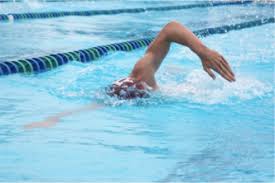First off, I look at Freestyle Recovery as dependent on Race Distance. Basically, it’s an inverse relationship. For example, the longer the race distance—the smaller Freestyle recovery level needed.
Basically, I define the Freestyle recovery through 3 DIFFERENT levels. There are long distance races, middle distance, and sprints–each with their own correlating recovery levels.
1.) Straight Arm Recovery

- Mostly seen in sprinters, and allows the stroke rate to get REALLY HIGH due to arm spending less time in air.
- Requires most energy from a swimmer, but it generates the MOST power & speed.
- Rotationally dependent—need MAX rotation for true straight arm Freestyle recovery!
2.) Active, 90-Degree Recovery

- Most common recovery.
- It is a good, middle ground that requires some work from the swimmer, but allows the stroke rate to increase too.
- Generates about a MEDIUM power output.
3.) Acute, Relaxed Recovery

- Primarily seen in distance swimmers.
- Requires the least amount of work to complete.
- Provides the lowest power output.
- Stroke Rate can’t get very high. Overall, a slower Freestyle recovery that’s very kick dependent.
When comparing these 3 Freestyle recovery levels, there’s a few common trends:
- You need more rotation the BIGGER the Freestyle recovery gets
- Your power increases the BIGGER the Freestyle recovery gets
- Kicking speed is important NO MATTER what Freestyle recovery level you’re performing—it is just HARDER to maintain a HIGHER speed with a smaller Freestyle recovery level, because proportionally the legs are doing MORE work with a SMALLER the Freestyle recovery level!
With this background of the webinar in mind, I had one coach, Jonathan (a Senior Level Coach from London), reached out to me via email and asked me a question about another post written on the affects of a SLOWER stroke rate INCREASING a swimmer’s Heart Rate and Oxygen Consumption. You can read this post [here].
What this article is talking about is how a swimmer’s turnover can AFFECT their effort level (mostly because a swimmer is forced into kicking harder to maintain speed and compensate for [an] overly long stroke with a slower stroke rate). There is a graph in the discussion portion of the article that shows a 10% INCREASE in turnover can actually,REDUCE energy expenditure (HR).
Here’s my two cents on this:
1.) Using your legs MORE will increase your Heart Rate!
- This article is right on the concept of using your legs more will affect your Heart Rate. This is due to the fact that the muscles in the legs are BIGGER than the muscles in your arms, your body will be MORE taxed the more you use your legs and tire sooner.
- Keep in mind: the more you work your legs and get into better philosophical shape (by improving your kicking speed)–the faster swimmer you will be.
2.) Increasing your stroke rate SHOULD increase your Heart Rate
- There’s very few swimmers who will increase their stroke rate and reduce their kicks–besides some distance swimmers.
- The purpose of manipulating the stroke rate to achieve a HIGHER stroke rate is toINCREASE speed.
- If you want to maximize speed, you need to utilize the four propulsive areas of the body (both arms and both legs)
- After all, you can achieve the SAME (High) Heart Rate level with either a straight arm Freestyle recovery or a relaxed, acute Freestyle recovery, depending on how much you emphasize the legs during a relaxed, acute Freestyle recovery.
3.) Conserving your legs during a race is OLD NEWS!
- The BEST swimmers have the leg speed to kick consistently for 1500m, 800m, 400m, or 500yds—FAST.
- When you look at many younger distance swimmers, open water swimmers, or triathletes—they’ve been taught to work primarily on their arms and forget the legs (either for the next portions of their races) or the legs will “tire” them out too quickly for their race distance!
- This mindset of picking where to INCREASE your leg speed is OLD NEWS. If you want to stay up with the FASTEST swimmers in the world, you need to KICK FAST!
- Need help learning how to KICK FAST, read my Freestyle kicking series!
So while I do agree with some of the foundations of the article mentioned above, at Swim Like A. Fish we primarily deal with competitive pool swimmers who are trying to be the FASTEST they can be in the pool.
There is definitely NO ONE SIZE FITS ALL equation for FAST swimming, but there are some common trends to the WORLD’S MOST ELITE Swimmers. After all, do you see Katie Ledecky ever rocking a 2-beat kick? Take a look below.
P.S. I’ll give you a hint—there answer is NO!
Until Next Time,
A. Fish

One Response
Excellent